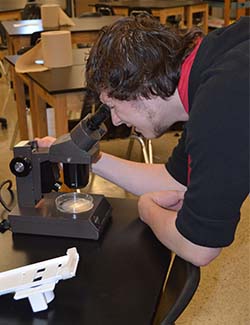Jonathon Haskill peered into the microscope at minuscule eggs as he described how he and his classmates have tested again and again the right salinity and pH levels for those little eggs to hatch into brine shrimp.
In the East Kentwood High School classroom next door, Reagan Olson showed the tiny shrimp after they hatch, early in their life cycle, swimming in a hatchery she and her classmates set up.
“If you look really, really close you can see them swimming around,” Reagan said.
When the shrimp get big enough, Reagan and her classmates in Advanced Placement Environmental Science will move them toa bigger tank and, eventually, on to become fish food.
It’s been a system of trial and error for students monitoring the hatching of the brine shrimp, also known as “sea monkeys,” and charting the results in different conditions like temperature and salinity level. The painstaking process is creating a sustainable way to continue breeding and learning about brine shrimp and fish.
Three classes are working together to create the food supply for neon angel fish, which they also breed in class. Students are learning the creatures have to have conditions just right to proliferate.

Delicate Balances
“One thing can ruin everything,” said Reagan of how the animals can quickly die if conditions change suddenly.
“It can be frustrating. It brings up a lot of problem-solving,” added Chani Warfield.
The AP classes all are playing different roles in the project: biology students research optimal conditions for the aquatic crustaceans; environmental science learners design the hatchery to continue breeding them; and statistics students make sure the science class members are supporting their conclusions mathematically. Students are also breeding the fish while experimenting with genetics.
The project is an example of open-inquiry science, teacher Chad VanHouten said. Students structure their experiments after several months developing the skills, confidence and knowledge base to do so. They’ve been taught that if an experiment doesn’t work, it doesn’t mean “it’s wrong,” but that it had a different outcome that they expected, VanHouten said.
“It’s really engaging,” said senior Jada Duong. “If something goes wrong, you understand what’s going wrong. Our experiments are based on our own group work. We don’t get specific instructions. We get to do our own thing.”









